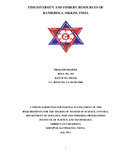Please use this identifier to cite or link to this item:
https://elibrary.tucl.edu.np/handle/123456789/3555Full metadata record
| DC Field | Value | Language |
|---|---|---|
| dc.contributor.author | Sharma, Prakash | - |
| dc.date.accessioned | 2021-07-27T08:47:14Z | - |
| dc.date.available | 2021-07-27T08:47:14Z | - |
| dc.date.issued | 2011 | - |
| dc.identifier.uri | http://elibrary.tucl.edu.np/handle/123456789/3555 | - |
| dc.description.abstract | The present study entitled” Fish Diversity and “Fishery Resources of Rani khola , Sikkim India" deals with the distribution, diversity and frequency occurrence of fish and invertebrates in Rani khola. The study also attempts to unveil the water quality of Rani khola, present socio- economic status of the fishermen living in the vicinity of Rani khola and existing fishing practices in Rani khola. Altogether eight species of fish fauna under two orders, two families, two genera, twelve species of invertebrates under three phyla, five classes and twelve orders were collected. The most common and dominant species of fish recorded was Schizothoraichthys progastus with the highest frequency occurrence of 23.41 %. All the invertebrates recorded during the field visits were found uniformly distributed where as the distribution of fishes remained mid range migratory as well as residential. The physico-chemical parameters of water were found very ideal providing a suitable environment for all the aquatic fauna. The water temperature ranges from 6.3 to 160C. Other parameters such as dissolved oxygen were found very optimum with an average value of 9.7 mg/l and free carbon dioxide were found with an average value of 3.15mg/l.No published literature available on fish diversity of Rani khola. The socio-economic condition of the fishermen living in the vicinity of Rani khola were found quite poor and 40% of them were totally illiterate. They were known to use the various types of conventional as well as non conventional fishing methods like netting, using, basket cage, rod and line, snare loops, blasting, poisoning, grabing. The riverine environment of the Rani khola is degrading rapidly due to both natural and manmade causes leading to sharp declination in diversity and fish population. The major problems of this river are sand and stone mining over exploitations of fish with illegal fishing practices, soil erosion and unusual flooding | en_US |
| dc.language.iso | en_US | en_US |
| dc.publisher | Central Department of Zoology | en_US |
| dc.subject | Fishery resources | en_US |
| dc.subject | invertebrates | en_US |
| dc.title | Fish Diversity and Fishery Resources of Ranikhola, Sikkim, India | en_US |
| dc.type | Thesis | en_US |
| local.institute.title | Central Department of Zoology | en_US |
| local.academic.level | Masters | en_US |
| Appears in Collections: | Zoology | |
Files in This Item:
| File | Description | Size | Format | |
|---|---|---|---|---|
| chapter.pdf | 777.53 kB | Adobe PDF |  View/Open | |
| Cover.pdf | 57.31 kB | Adobe PDF |  View/Open |
Items in DSpace are protected by copyright, with all rights reserved, unless otherwise indicated.
